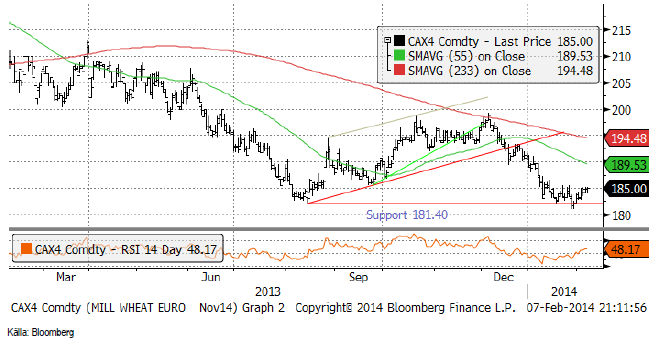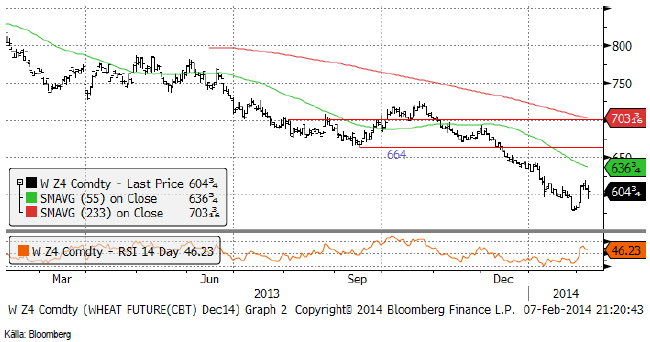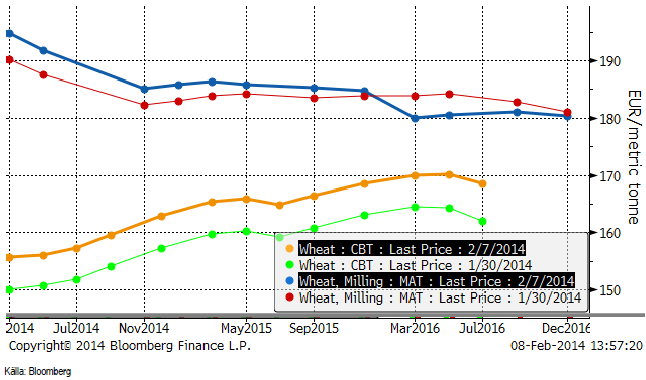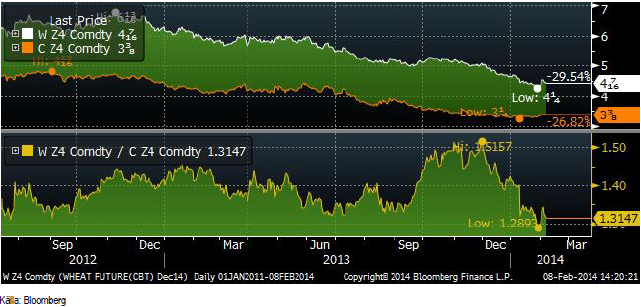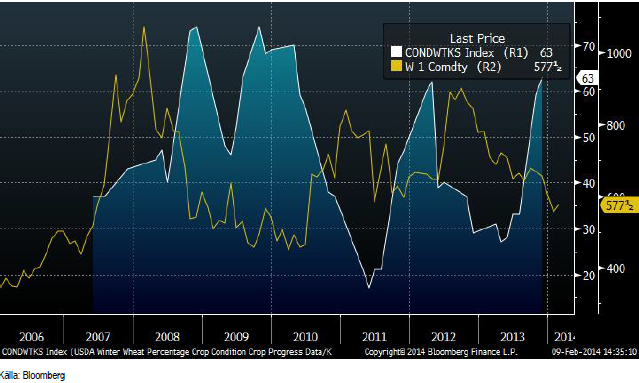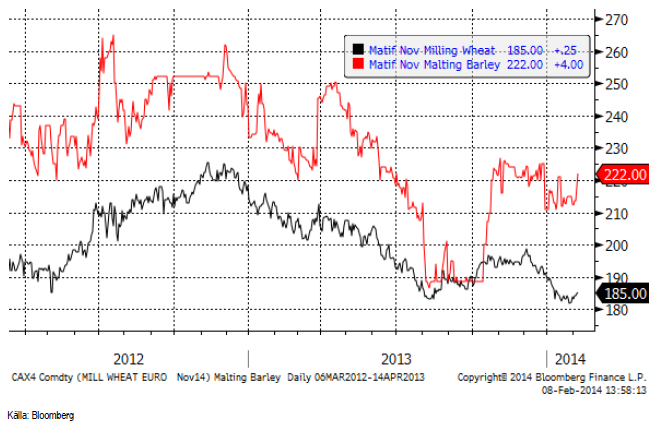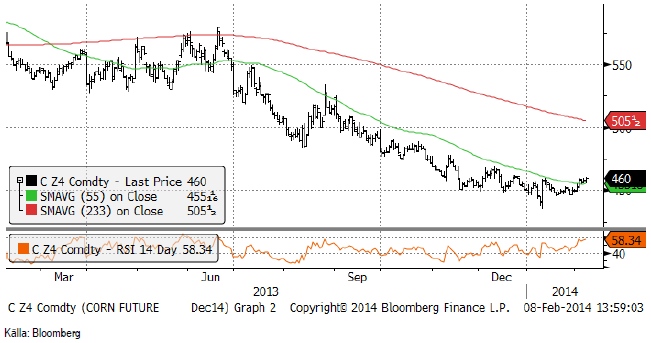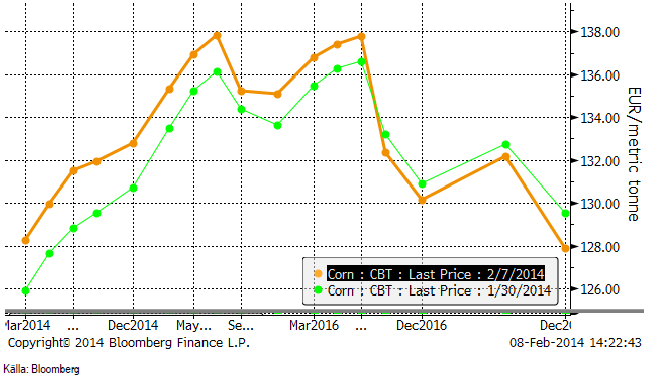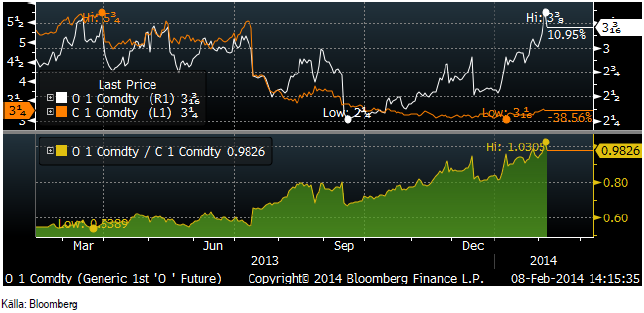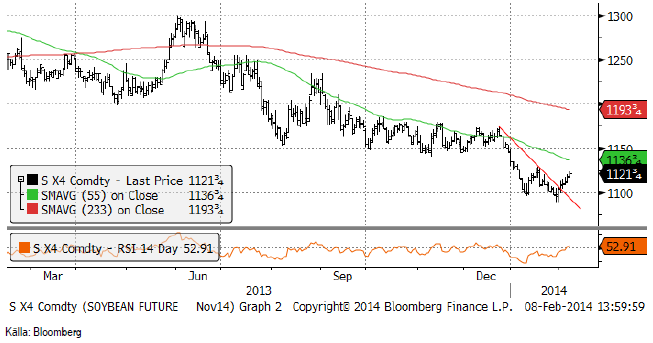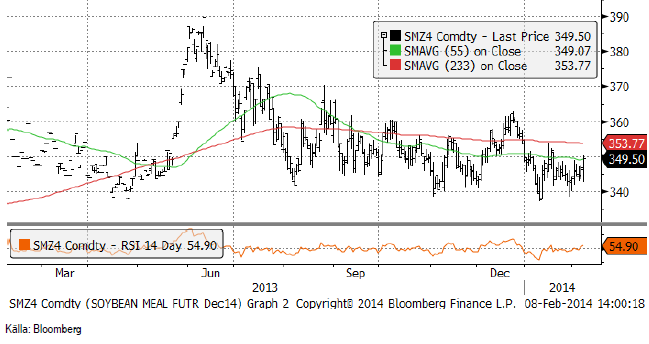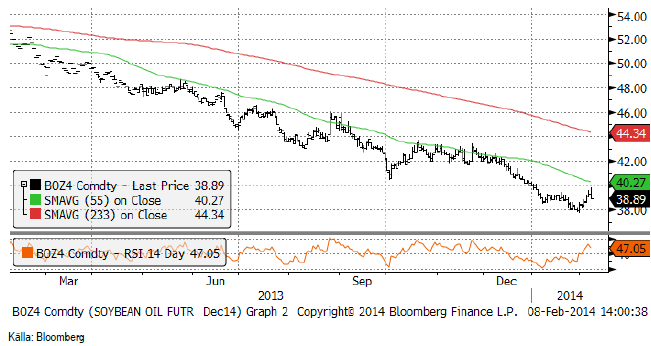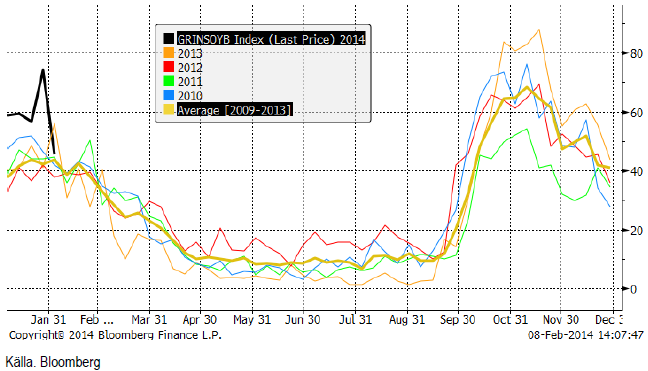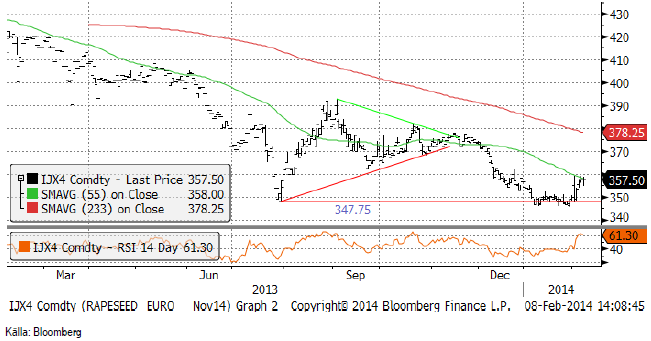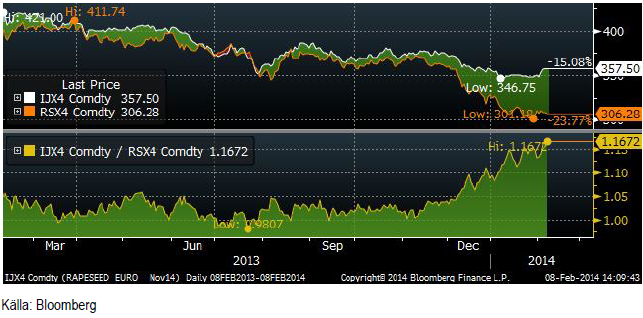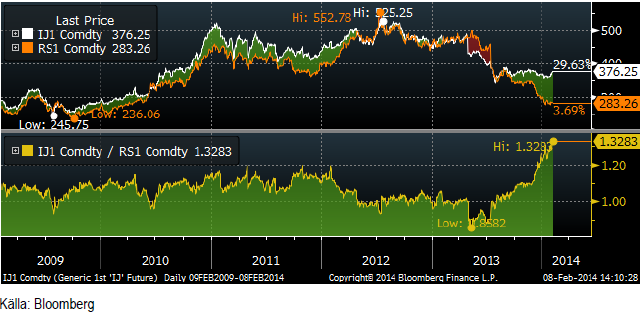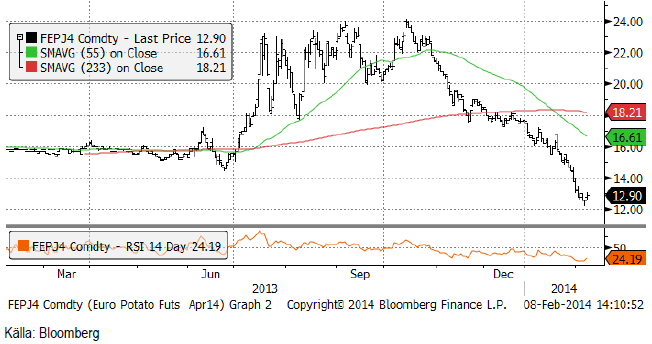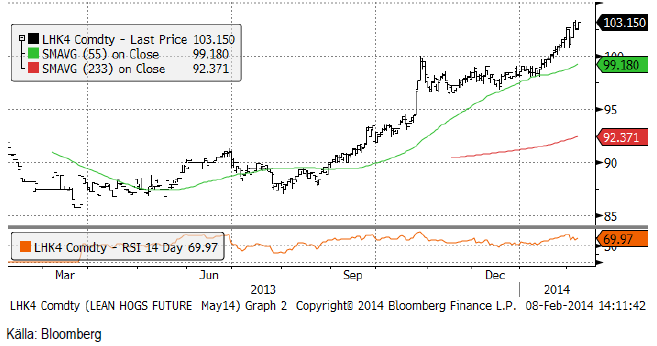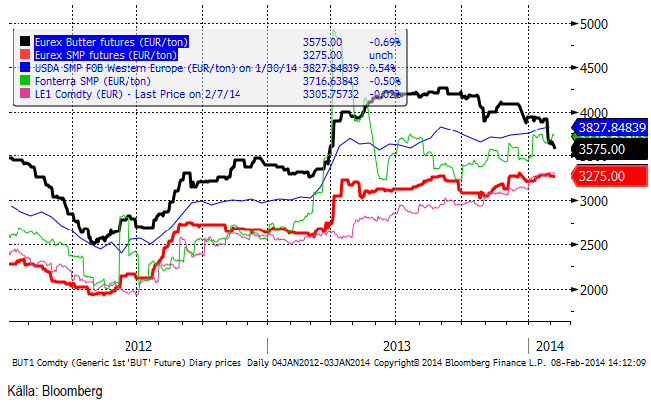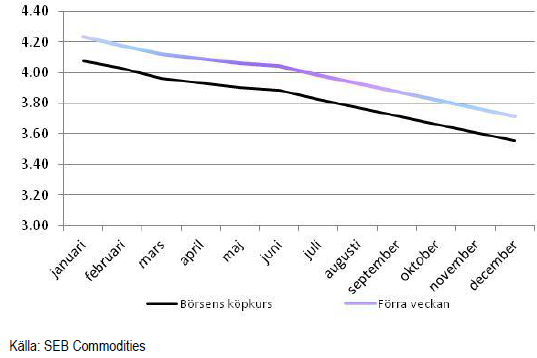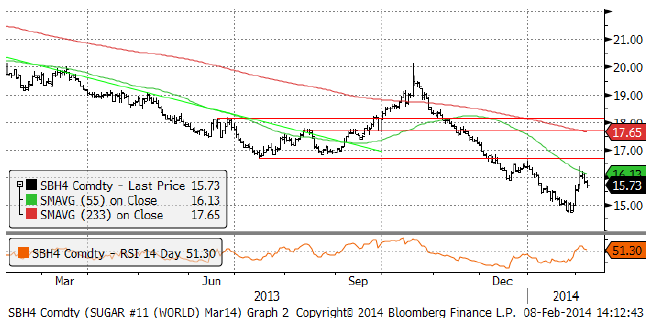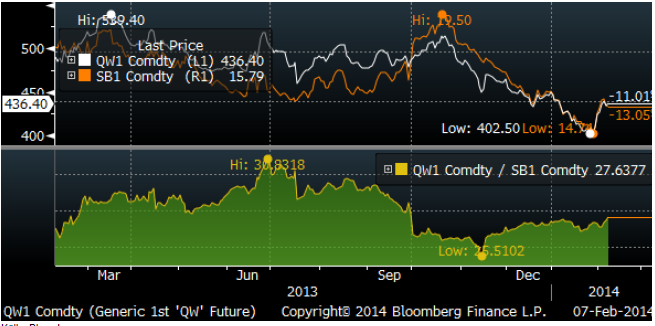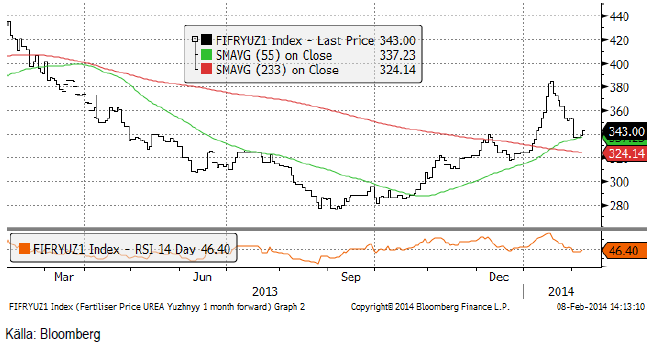Analys
SEB Jordbruksprodukter, 10 februari 2014


 Det amerikanska jordbruksdepartementet USDA publicerar sin WASDE-rapport på måndag klockan 18. Handlare och analytiker som tillfrågats av Bloomberg förväntar sig en nedjustering av globala utgående lager för vete och majs.
Det amerikanska jordbruksdepartementet USDA publicerar sin WASDE-rapport på måndag klockan 18. Handlare och analytiker som tillfrågats av Bloomberg förväntar sig en nedjustering av globala utgående lager för vete och majs.
För första gången sedan slutet av december förväntar sig en majoritet av de tillfrågade handlarna och analytikerna att priset på majs och vete går upp nästa vecka. Vad gäller majs är de på den mest positiva sidan sedan augusti förra året. Beträffande soja tror de på prisuppgång för första gången på tre veckor.
Februari-WASDE brukar inte vara någon stor händelse, men i den stiltje som marknaden befinner sig i, kan den möjligtvis ge styrfart åt något håll – uppåt eller nedåt.
Odlingsväder
Viktigast just nu är den torka som drabbat Brasilien. Efter den torraste perioden sedan 1954 i Minas Gerais, väntas nu regn om ca en vecka. Södra Brasilien och norra Argentina har fått mer än normal nederbörd, eftersom lågtrycket stannat där, blockerat av högtrycket över centrala och östra Brasilien. Torkan påverkar även betet. Landet är som bekant en stor kött- och mjölkproducent och när betet tryter blir konsumtionen av spannmål högre.
Kina, som varit torrt, väntas få betydligt mer nederbörd än det normala de kommande två veckorna enligt GFS-modellen.
Europa väntas få väsentligt mycket mer nederbörd än normalt, utom i södra Italien och längs Norges kust.
USA, som varit kallt och torrt, kommer att få ordentligt med nederbörd de kommande två veckorna, men något mindre än normalt i Texas och angränsande delstater.
Vete
Matifs novemberkontrakt gick inte genom 180 euro per ton. I fredags stängde marknaden på 185 euro, som är den övre delen av det smala prisintervall om 5 euro som marknaden handlat inom den senaste månaden.
Nedanför ser vi Chicagovetet (Dec 14), som stängde fredagen på 598.50 cent / bushel – under den psykologiskt viktiga nivån 600 cent.
Nedan ser vi terminskurvorna för Chicagovete och Matif, båda uttryckta i euro per ton. Exportframgångarna för Rouen bidrar till att kurvan gått mer in i backwardation. I Chicago, där terminsmarknaden vanligtvis är i contango, har kurvan flackat, i synnerhet för gammal skörd.
Vetekontrakten för decemberleverans i Chicago har blivit billigare än någonsin tidigare i förhållande till majs. Tidigare har vi sett spotpriset på majs ligga över majspriset, men inte i kontrakten för ny skörd. Vete ser alltså ”billigt” ut i förhållande till majs nu.
Crop condition som NASS i några delstater publicerade i måndags den 3 februari var en chock för marknaden. I Kansas är 3% av höstvetet ”very poor”, 17% ”poor”, 45% ”fair”, 33% ”good” och 2% ”excellent”. När höstvetet gick in i vintervilan vid den sista crop condition-rapporten den 22 november var 63% i good/excellen condition. Nu är det alltså 35%, dvs 28%-enheter lägre.
Situationen påminner lite om vintern 2009/2010, när vetet gick in i vintervilan på 69% good/excellent. Priset på vete var naturligtvis lågt. När sedan crop condition föll under 2010, kunde priset stiga från en låg nivå under haussartade former senare på hösten. Nedan ser vi historiken på crop condition i Kansas och priset på spotkontraktet (W1) i Chicago.
Crop condition sjönk i fler delstater: Texas 19% good/excellent (-13%) och Oklahoma 36% (-40%). Det är något för torrt i marken skriver NASS i sina kommentarer.
Stats Canada som kom i mitten av veckan visade på lager på 28.3 mt, väsentligt högre än förra årets 20.5 mt, men i linje med förväntningarna. Den varslade tågstrejken i Kanada ställdes in på order av regeringen.
FAO meddelade så sent som den 28 januari att Iran kommer att importera 10.7 mt spannmål i år, ner från 14.2 mt förra året, men landet verkar importera mer än så. Importbehovet av vete anges av FAO till 4 mt. I veckan köpte landet 0.5 mt från EU och Ryssland. I veckan anklagades också regeringen i Iran för att ha skickat falska uppgifter till FAO.
Marknaden förväntar sig att USDA ska lämna carry-out stocks i USA oförändrade på 608 mbu i måndagens rapport, enligt en sammanställning gjord av Bloomberg. Men man förväntar sig en sänkning av lagren av majs och en stark majsmarknad kan dra vetepriset högre.
Det mest sannolika är att priset på vete går ner, men ”risk/reward” är helt klart på uppsidan, så vi väljer att gå ur korta positioner på vete. Än så länge stannar vi med neutral rekommendation.
Maltkorn
November 2014 – kontraktet på maltkorn håller sig stabilt när vetet visar svaghet. Som vi skrev i höstas, är maltkorn förmodligen en gröda som bör betala sig bra i år. Dessutom är det fotbolls-VM i sommar och kan öka efterfrågan på maltkorn. I veckan handlades terminerna för novemberleverans upp till 222 euro per ton och vidgade därmed premien till kvarvetekontrakten på Matif.
Majs
Majsmarknaden ser ut att vara på väg att ha avslutat sin fallande pristrend och börja vända upp. Vi rekommenderar köp av majs nu, från tidigare neutral vy.
Det är framförallt de kortare terminskontrakten som gått upp, medan de riktigt långa gått ner.
Terminerna på havre gick i veckan över priset på majs. Det här gäller för spotkontrakten och orsakades i veckan som gick framförallt av den befarade tågstrejken i Kanada, som dock inte blev av. Decemberkontraktet på havre handlas alltjämt till 60% av priset för majs, så det här handlar om en bristsituation just nu. Det är möjligtvis ett bra tillfälle att sälja havre till USA nu.
Det är väldigt torrt i östra Brasilien, främst i delstaterna Minas Gerais och Espirito Santo, men som vi skrivit är det torrt även i Goias, Sao Paulo och upp mot Mato Grosso. Medan detta är bra för skörden av sojabönor, är det mindre bra för den andra skörden, som till stor del utgörs av majs. Vi tror att många kommer att försöka odla soja (igen). Torrt väder är inte bra för någon av grödorna.
Terminerna i USA på etanol nådde sin högsta nivå på sju månader i veckan.
Exporten från USA är liksom för soja, högre än normalt. 91% av den volym USDA har estimerat för export i år är redan såld, efter veckans stora export på 1.7 mt.
Marknaden förväntar sig att USDA ska sänka carry-out stocks i USA från 1631 mbu till 1616 mbu i måndagens rapport, enligt en sammanställning gjord av Bloomberg.
Vi går alltså över till köprekommendation på majs.
Sojabönor
Sojabönorna steg över ett tekniskt motstånd i veckan som gick och stängde 21 cent över stödnivån på 1100 cent per bushel.
Sojamjölet håller sig kvar i intervallet 340 – 360 dollar per short ton.
Sojaoljan gick inte under 38 dollar och har sedan vänt upp med stöd av prisutvecklingen på palmoljan i Malaysia.
Exportstatistiken fortsätter att vara starkare än normalt, även om det uppenbarligen börjar ta slut på sojabönor i USA:s lager. Brasiliens skörd är till 10% klar och de första lasterna gick iväg från hamnarna för nästan två veckor sedan.
Situationen i Argentina är präglad av regeringens panik att få in skatteinskomster. De exportföretag som inte exporterar hotades med nationalisering i veckan som gick. Staten kräver att lantbrukarna ska sälja, men dessa håller naturligtvis emot så gott de kan.
Marknaden förväntar sig att USDA ska sänka carry-out stocks i USA från 150 mbu till 145 mbu i måndagens rapport, enligt en sammanställning gjord av Bloomberg.
Raps
November 2014-kontraktet på raps följde sojabönorna upp i veckan som gick. Rapskaka har som bekant blivit ett viktigt alternativ i foderblandningarna i EU till sojabönor. Vi tycker dock alltjämt att rapspriset för ny skörd borde vara väsentligt lägre och tycker att den här prisuppgången ger ett utmärkt tillfälle att sälja terminer för ny skörd.
Marknaden blev mycket oroad av strejkvarslet från järnvägsanställda i Kanada. I onsdags nåddes dock marknaden av att strejken var avblåst. Den kanadensiska regeringen förbjöd dem att strejka, eftersom detta skulle ha skadat landets export av jordbruksprodukter och andra råvaror.
Terminskontrakten på Canola i Winnipeg har fortsatt att falla fritt, även sedan förra veckan. Statistics Canadas lagerstatistik visade på lager på 12.6 mt, 56% mer än förra året. Skillnaden mellan canola-kontraktet för novemberleverans och matifs på rapsfrö, har ökat från 12.7% för två veckor sedan till 16.7%. Det innebär att rapsfrökontraktet är minst 12- 14% för dyrt i förhållande till den tidigare etablerade relationen.
I diagrammet nedan ser vi hur spotkontrakten handlat mot varandra de senaste fem åren. Rapsfröet är helt enkelt onormalt dyrt just nu.
Vi fortsätter med säljrekommendation och upprepar den!
Potatis
När potatispriset i januari nådde ner till den prisnivå som etablerats under förra året på 16 euro per 100 Kg, och utbudet sedan fortsatte att överträffa efterfrågan, föll priset ner till 12 euro som lägst i veckan som gick. Potatis har varit en av de allra mest volatila jordbruksprodukterna det senaste året. Märkligt nog är det också en av de som prissäkras minst. Korrelationen mellan noteringen på Eurex, som i stor utsträckning är detsamma som priset i Holland, är låg till de olika svenska priserna, men inte på årsbasis. Är det i norra Kontinentaleuropa är det i regel torrt i Sverige och vice versa. Det innebär att priserna i stort sett rör sig åt samma håll.
Kontraktet för den kommande skörden börjar nu handlas allt mer. Nedan ser vi kurdiagrammet för april 2015-kontraktet. 14.40 euro per 100 Kg är väsentligt lägre än de 16 euro som priset började på. Marknaden kan se illikvid ut, men vi har inga problem att finna köpare av terminskontrakt på potatis för april 2015 och även för april 2016 – om det finns någon potatisodlare som vill bli av med den osäkerhet om priset som marknaden har.
Gris
Lean hogs maj-kontrakt har fortsatt att stiga och priset ligger nu över 100 cent per pund. Trenden är tydligt uppåtriktad, vilket innebär att det är mer sannolikt att priset fortsätter upp, än att det vänder ner.
Rysslands importstopp från EU, föranlett av ett sjukt vildsvin i Litauen (förmodligen smittat från Ryssland, som har sjukdomen), har fått priserna på griskött i EU att rasa. Eftersom sjukdomen finns i Ryssland och endast hos vildsvin vid Litauens östgräns är det rimligt att tro att detta är ett svepskäl från Rysslands sida. Ryssland har i flera år haft en vilja att minska importberoendet och bygga upp en egen grisnäring, baserad på den spannmål som produceras i allt större volymer. Utrotandet av sjukdomen hos vildsvin i EU kommer inte att ta bort det faktum att EU måste anpassa sig till en situation utan export till Ryssland. Ändå verkar det vara en överutbudssituation just nu. Spotkontraktet på Eurex handlas på motsvarande 13 kr per kilo. Marknaden är i kraftigt conango, nästan 50% omräknat till årsbasis. Juli-kontraktet handlas på över 15 kr per kilo. Den som är orolig för att även dessa priser ska falla kan naturligtvis prissäkra genom att sälja terminskontrakt på den väntade produktionen i juli (och övriga månader).
Mjölk
Prisfallet på smör har fortsatt på Eurex. SMP håller fortfarande emot. Eftersom priset på smör faller, innebär det att priset på mjölkråvara faller. Vi har sett priset på smör backa sedan månadsskiftet oktober / november förra året, försiktigt i början men nu med en tydligt fallande pristrend. SMP har fortsatt att stiga, men hittills i år har vi inte längre noterat någon prisuppgång på Eurexmarknaden. Fonterra har däremot utvecklats positivt.
Nedan ser vi prisutvecklingen på Eurex smör och pulver (de feta linjerna), samt på USDA:s notering av SMP (FOB Västeuropa), Chicagopriset i euro per ton och Fonterras pris; Fonterra faktiskt lite lägre den här veckan.
LTO Nederland rapporterade i fredags att mjölkpriset i EU föll med 1.6% i december från rekodnivån i november. På sin hemsida skriver de att priset i december var 40.55 euro per 100 Kg i november och det föll till 39.89 euro i december. De skriver också att den ökande produktionen av mjölk i de viktigaste producentländerna i världen är ett hot mot prisnivån och har gjort marknaden mer sårbar. Skriver att prispressen kan intensifieras tidigare än vanligt, kanske redan till slutet av det första kvartalet i år.
Nedan ser vi terminspriserna man får i svenska kronor från terminspriserna på SMP och smör på Eurex, omräknat till kronor per kilo mjölkråvara. Notera att hela den här prisnivån alltid ska ligga över avräkningspriset på mjölkråvara med ca 50 öre, som är en uppskattning av kostnaden för att förädla mjölkråvara till SMP och smör.
Som vi redan sett har terminspriserna fallit. Det är möjligt att detta är inledningen på det prisfall som har befarats.
Socker
Marskontraktet på råsocker rekylerade upp kraftigt efter att informationen om torka i Brasilien sjönk in hos marknadsaktörerna. Torkan har dock inte drabbat de områden där sockerrör odlas lika hårt som områden där kaffe odlas.
Ecom Industrial Group sade dock i söndags (9 feb) att torkan kan innebära att Brasiliens produktion av socker blir 5% lägre än under 2013. Uttalandet gjordes på Kingsmans konferens i Dubai, som pågår till tisdag.
Kingsman själva som publicerade sin första rapport för året 2014/15, sade att detta blir det femte året med överskott i utbuds / efterfrågebalansen för socker. Global produktion förutspås stiga till 181 mt från 177.7 mt. Konsumtionen väntas öka med 2% till 178.96 mt. Skillnaden är drygt 2 mt, som alltså läggs till lagren. Orsaken till produktionsökningen anser Kingsman är att olika statliga stöd förhindrar prissignalen (lågt pris) att påverka produktionen. Svagare valutor i länder som producerar socker, t ex Brasilien, vars valuta fallit med 13% mot dollarn det senaste året, gör också att prisfallet inte upplevs på samma sätt av producenterna.
I fredags sammanträdde kabinettet i den indiska regeringen för att diskutera höjningen av exportbidraget för socker till motsvarande 56 USD / ton. Det är en höjning med 75%. Syftet är att exporten ska uppgå till 4 miljoner ton över de kommande två åren. Man hoppas att priset därmed ska bli högre inom landet.
Brasiliens UNICA svarade i fredags att alla former av exportbidrag är ett brott mot WTO-reglerna. UNICA menar att Indiens olagliga exportstöd tvingar producenter i Thailand, Australien, Colombia, Guatemala och Brasilien att minska sin produktion.
Brasilianskt råsocker har nästan alltid handlats till ett premium över terminsnoteringen på NYBOT i New York. Sedan oktober har priset emellertid legat under, vilket delvis hänger ihop med att skörden tas in under hösten.
När vi ser att kvoten mellan terminskontraktet för raffinerat vitt socker och råsocker minskade i början på oktober, måste vi också betänka att då började brasilianskt råsocker att handla under prisnoteringen på börsen. Nedan ser vi en bild på kvoten mellan priset på vitt socker (i dollar / ton) och priset på råsocker (i cent / pund).
Torkan i Brasilien är den enda faktor som är bulllish för socker. Men det är inte torrast där sockerrör odlas. Vi är hellre köpta kaffe än socker av den anledningen.
Gödsel
Urean sjönk tillbaka, men är alltjämt i stigande trend.
[box]SEB Veckobrev Jordbruksprodukter är producerat av SEB Commodities Sales desk och publiceras i samarbete och med tillstånd på Råvarumarknaden.se[/box]
Detta marknadsföringsmaterial, framtaget av SEB’s Commodities Sales desk, har upprättats enbart i informationssyfte.
Även om innehållet är baserat på källor som SEB bedömt som tillförlitliga ansvarar SEB inte för fel eller brister i informationen. Den utgör inte oberoende, objektiv investeringsanalys och skyddas därför inte av de bestämmelser som SEB har infört för att förebygga potentiella intressekonflikter. Yttranden från SEB’s Commodities Sales desk kan vara oförenliga med tidigare publicerat material från SEB, då den senare hänvisas uppmanas du att läsa den fullständiga rapporten innan någon åtgärd vidtas.
Dokumentationen utgör inte någon investeringsrådgivning och tillhandahålls till dig utan hänsyn till dina investeringsmål. Du uppmanas att självständigt bedöma och komplettera uppgifterna i denna dokumentation och att basera dina investeringsbeslut på material som bedöms erforderligt. Alla framåtblickande uttalanden, åsikter och förväntningar är föremål för risker, osäkerheter och andra faktorer och kan orsaka att det faktiska resultatet avviker väsentligt från det förväntade. Historisk avkastning är ingen garanti för framtida resultat. Detta dokument utgör inte ett erbjudande att teckna några värdepapper eller andra finansiella instrument. SEB svarar inte för förlust eller skada – direkt eller indirekt, eller av vad slag det vara må – som kan uppkomma till följd av användandet av detta material eller dess innehåll.
Observera att det kan förekomma att SEB, dess ledamöter, dess anställda eller dess moder- och/eller dotterbolag vid olika tillfällen innehar, har innehaft eller kommer att inneha aktier, positioner, rådgivningsuppdrag i samband med corporate finance-transaktioner, investment- eller merchantbankinguppdrag och/eller lån i de bolag/finansiella instrument som nämns i materialet.
Materialet är avsett för mottagaren, all spridning, distribuering mångfaldigande eller annan användning av detta meddelande får inte ske utan SEB:s medgivande. Oaktat detta får SEB tillåta omfördelning av materialet till utvald tredje part i enlighet med gällande avtal. Materialet får inte spridas till fysiska eller juridiska personer som är medborgare eller har hemvist i ett land där sådan spridning är otillåten enligt tillämplig lag eller annan bestämmelse.
Skandinaviska Enskilda Banken AB (publ) är ett [publikt] aktiebolag och står under tillsyn av Finansinspektionen samt de lokala finansiella tillsynsmyndigheter i varje jurisdiktionen där SEB har filial eller dotterbolag.
Analys
Tightening fundamentals – bullish inventories from DOE

The latest weekly report from the US DOE showed a substantial drawdown across key petroleum categories, adding more upside potential to the fundamental picture.

Commercial crude inventories (excl. SPR) fell by 5.8 million barrels, bringing total inventories down to 415.1 million barrels. Now sitting 11% below the five-year seasonal norm and placed in the lowest 2015-2022 range (see picture below).
Product inventories also tightened further last week. Gasoline inventories declined by 2.1 million barrels, with reductions seen in both finished gasoline and blending components. Current gasoline levels are about 3% below the five-year average for this time of year.
Among products, the most notable move came in diesel, where inventories dropped by almost 4.1 million barrels, deepening the deficit to around 20% below seasonal norms – continuing to underscore the persistent supply tightness in diesel markets.
The only area of inventory growth was in propane/propylene, which posted a significant 5.1-million-barrel build and now stands 9% above the five-year average.
Total commercial petroleum inventories (crude plus refined products) declined by 4.2 million barrels on the week, reinforcing the overall tightening of US crude and products.


Analys
Bombs to ”ceasefire” in hours – Brent below $70

A classic case of “buy the rumor, sell the news” played out in oil markets, as Brent crude has dropped sharply – down nearly USD 10 per barrel since yesterday evening – following Iran’s retaliatory strike on a U.S. air base in Qatar. The immediate reaction was: “That was it?” The strike followed a carefully calibrated, non-escalatory playbook, avoiding direct threats to energy infrastructure or disruption of shipping through the Strait of Hormuz – thus calming worst-case fears.

After Monday morning’s sharp spike to USD 81.4 per barrel, triggered by the U.S. bombing of Iranian nuclear facilities, oil prices drifted sideways in anticipation of a potential Iranian response. That response came with advance warning and caused limited physical damage. Early this morning, both the U.S. President and Iranian state media announced a ceasefire, effectively placing a lid on the immediate conflict risk – at least for now.
As a result, Brent crude has now fallen by a total of USD 12 from Monday’s peak, currently trading around USD 69 per barrel.
Looking beyond geopolitics, the market will now shift its focus to the upcoming OPEC+ meeting in early July. Saudi Arabia’s decision to increase output earlier this year – despite falling prices – has drawn renewed attention considering recent developments. Some suggest this was a response to U.S. pressure to offset potential Iranian supply losses.
However, consensus is that the move was driven more by internal OPEC+ dynamics. After years of curbing production to support prices, Riyadh had grown frustrated with quota-busting by several members (notably Kazakhstan). With Saudi Arabia cutting up to 2 million barrels per day – roughly 2% of global supply – returns were diminishing, and the risk of losing market share was rising. The production increase is widely seen as an effort to reassert leadership and restore discipline within the group.
That said, the FT recently stated that, the Saudis remain wary of past missteps. In 2018, Riyadh ramped up output at Trump’s request ahead of Iran sanctions, only to see prices collapse when the U.S. granted broad waivers – triggering oversupply. Officials have reportedly made it clear they don’t intend to repeat that mistake.
The recent visit by President Trump to Saudi Arabia, which included agreements on AI, defense, and nuclear cooperation, suggests a broader strategic alignment. This has fueled speculation about a quiet “pump-for-politics” deal behind recent production moves.
Looking ahead, oil prices have now retraced the entire rally sparked by the June 13 Israel–Iran escalation. This retreat provides more political and policy space for both the U.S. and Saudi Arabia. Specifically, it makes it easier for Riyadh to scale back its three recent production hikes of 411,000 barrels each, potentially returning to more moderate increases of 137,000 barrels for August and September.
In short: with no major loss of Iranian supply to the market, OPEC+ – led by Saudi Arabia – no longer needs to compensate for a disruption that hasn’t materialized, especially not to please the U.S. at the cost of its own market strategy. As the Saudis themselves have signaled, they are unlikely to repeat previous mistakes.
Conclusion: With Brent now in the high USD 60s, buying oil looks fundamentally justified. The geopolitical premium has deflated, but tensions between Israel and Iran remain unresolved – and the risk of missteps and renewed escalation still lingers. In fact, even this morning, reports have emerged of renewed missile fire despite the declared “truce.” The path forward may be calmer – but it is far from stable.
Analys
A muted price reaction. Market looks relaxed, but it is still on edge waiting for what Iran will do

Brent crossed the 80-line this morning but quickly fell back assigning limited probability for Iran choosing to close the Strait of Hormuz. Brent traded in a range of USD 70.56 – 79.04/b last week as the market fluctuated between ”Iran wants a deal” and ”US is about to attack Iran”. At the end of the week though, Donald Trump managed to convince markets (and probably also Iran) that he would make a decision within two weeks. I.e. no imminent attack. Previously when when he has talked about ”making a decision within two weeks” he has often ended up doing nothing in the end. The oil market relaxed as a result and the week ended at USD 77.01/b which is just USD 6/b above the year to date average of USD 71/b.

Brent jumped to USD 81.4/b this morning, the highest since mid-January, but then quickly fell back to a current price of USD 78.2/b which is only up 1.5% versus the close on Friday. As such the market is pricing a fairly low probability that Iran will actually close the Strait of Hormuz. Probably because it will hurt Iranian oil exports as well as the global oil market.
It was however all smoke and mirrors. Deception. The US attacked Iran on Saturday. The attack involved 125 warplanes, submarines and surface warships and 14 bunker buster bombs were dropped on Iranian nuclear sites including Fordow, Natanz and Isfahan. In response the Iranian Parliament voted in support of closing the Strait of Hormuz where some 17 mb of crude and products is transported to the global market every day plus significant volumes of LNG. This is however merely an advise to the Supreme leader Ayatollah Ali Khamenei and the Supreme National Security Council which sits with the final and actual decision.
No supply of oil is lost yet. It is about the risk of Iran closing the Strait of Hormuz or not. So far not a single drop of oil supply has been lost to the global market. The price at the moment is all about the assessed risk of loss of supply. Will Iran choose to choke of the Strait of Hormuz or not? That is the big question. It would be painful for US consumers, for Donald Trump’s voter base, for the global economy but also for Iran and its population which relies on oil exports and income from selling oil out of that Strait as well. As such it is not a no-brainer choice for Iran to close the Strait for oil exports. And looking at the il price this morning it is clear that the oil market doesn’t assign a very high probability of it happening. It is however probably well within the capability of Iran to close the Strait off with rockets, mines, air-drones and possibly sea-drones. Just look at how Ukraine has been able to control and damage the Russian Black Sea fleet.
What to do about the highly enriched uranium which has gone missing? While the US and Israel can celebrate their destruction of Iranian nuclear facilities they are also scratching their heads over what to do with the lost Iranian nuclear material. Iran had 408 kg of highly enriched uranium (IAEA). Almost weapons grade. Enough for some 10 nuclear warheads. It seems to have been transported out of Fordow before the attack this weekend.
The market is still on edge. USD 80-something/b seems sensible while we wait. The oil market reaction to this weekend’s events is very muted so far. The market is still on edge awaiting what Iran will do. Because Iran will do something. But what and when? An oil price of 80-something seems like a sensible level until something do happen.
-

 Nyheter4 veckor sedan
Nyheter4 veckor sedanStor uppsida i Lappland Guldprospekterings aktie enligt analys
-

 Nyheter4 veckor sedan
Nyheter4 veckor sedanSilverpriset släpar efter guldets utveckling, har mer uppsida
-

 Nyheter3 veckor sedan
Nyheter3 veckor sedanUppgången i oljepriset planade ut under helgen
-

 Nyheter2 veckor sedan
Nyheter2 veckor sedanMahvie Minerals växlar spår – satsar fullt ut på guld
-

 Nyheter3 veckor sedan
Nyheter3 veckor sedanLåga elpriser i sommar – men mellersta Sverige får en ökning
-

 Analys3 veckor sedan
Analys3 veckor sedanVery relaxed at USD 75/b. Risk barometer will likely fluctuate to higher levels with Brent into the 80ies or higher coming 2-3 weeks
-

 Nyheter2 veckor sedan
Nyheter2 veckor sedanOljan, guldet och marknadens oroande tystnad
-

 Nyheter2 veckor sedan
Nyheter2 veckor sedanJonas Lindvall är tillbaka med ett nytt oljebolag, Perthro, som ska börsnoteras


